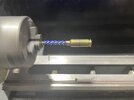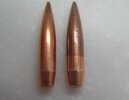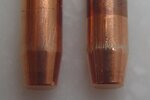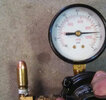I think the data shows that adding this step supports neck tension/bullet hold consistency.
What do you guys think?
Consistency is definitely the key in my mind, however anyone do theirs.
I go to great lengths to have my necks clean, brushing a lot during prep. I use no lube inside necks, and by the time I decap, anneal, tumble, size/lube, tumble, trim/chamfer/deburr, tumble, brushing the necks at each junction, they are consistently clean and uniform inside. I brush after trimming/deburring/chamfering,
then tumble, then brush again. I want that case neck entrance clean and smooth as I can get it. No burrs, not corncob grit, no whatever.

I want to avoid damaging jackets that affects BC.
Left is chamfered, right is not. Extreme I know, but it shows what can happen. I want smoooooth. So, light, but not too light, neck tension.








